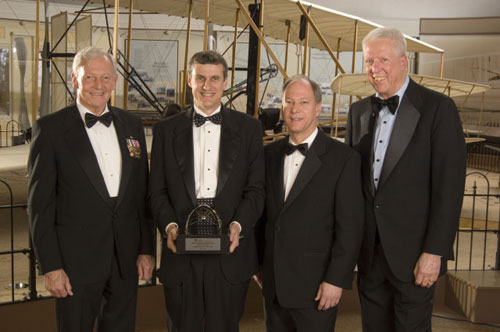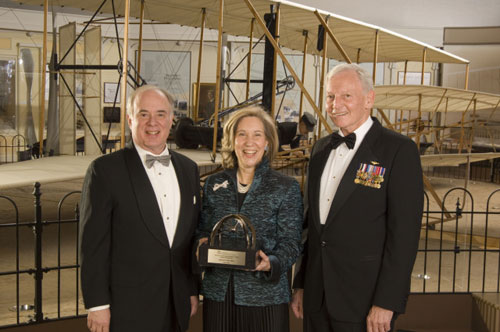posted 03-09-2006 08:27 PM




National Air and Space Museum releaseMars Exploration Rover Team and James Van Allen are Smithsonian's National Air and Space Museum Trophy Winners
The National Air and Space Museum Trophy, the museum’s highest honor, has been awarded this year to the team responsible for the ongoing Mars Exploration Rover missions, and pioneer space scientist Dr. James Van Allen. The MER team is honored in the category of Current Achievement and Van Allen in the category of Lifetime Achievement.
The awards were presented at a private ceremony at the Smithsonian’s National Air and Space Museum building in Washington on March 9. Van Allen, who did not attend, was represented by his daughter. Established in 1985, the award recognizes outstanding achievement in scientific or technological endeavors relating to air and space technology and exploration. As in past years, trophy winners received a miniature version of "The Web of Space," a sculpture by artist John Safer.
For more information on the National Air and Space Museum Trophy and other awards in the museum's collections, visit www.nasm.si.edu/research/aero/trophy/.
The National Air and Space Museum building on the National Mall in Washington, D.C., is located at Sixth Street and Independence Avenue S.W. The museum's Steven F. Udvar-Hazy Center is located in Chantilly, Va. near Washington Dulles International Airport.
Both facilities are open daily from 10 a.m. until 5:30 p.m. (Closed Dec. 25) Admission is free but there is a $12 fee for daily parking at the Udvar-Hazy Center. Shuttle bus service runs between the facilities with a roundtrip ticket costing $12. (Group discounts are available)
The 2005 National Air and Space Museum Trophy event was made possible through the generous support of Lockheed Martin Corp.
The Mars Exploration Rover Team

The Mars Exploration Rover (MER) Team is honored for its design, construction, deployment and management of two robotic rovers that began exploring the Red Planet in January 2004.
The success of the MER missions has come from the hard work of many people. Since landing as planned on opposite sides of Mars, the rovers have required almost around-the-clock direction by scientists and engineers back on Earth—primarily at the Jet Propulsion Laboratory in Pasadena, California, but also at many other institutions across the country, including the National Air and Space Museum.
On Jan. 3, 2004, the rover “Spirit” landed on Mars in Gusev crater, followed on Jan. 25 by “Opportunity” landing in the Sinus Meridiani region, halfway around the planet from its twin. In both cases, the unique entry, descent and landing system of heat shields, parachutes, rockets and airbags worked to perfection. Because of the 12-minute time delay in sending radio signals to and from Mars, a safe landing depended on each rover’s autonomous execution of a complex sequence of operations within a 6-minute framework.
Following the landings, scientific discoveries came in quick succession. A sophisticated robot arm called the Instrument Deployment Device enabled each rover to deploy tools precisely as needed. Among those was the Rock Abrasion Tool, the first such device to allow scientists to scour beneath dust-coated rock surfaces on Mars. Such devices, combined with on-board systems, allowed the rovers to duplicate many of the activities of a human geologist and achieve remarkable success. A key mission highlight was the discovery of evidence that both sites once had considerable water present—the primary scientific objective of the entire mission.
Both rovers have operated well beyond their designed minimum lifetimes of 90 days. They also have driven many times the 600-meter distance NASA established as a criterion of success—covering more than 12 kilometers with both rovers.
At the end of 2005, both rovers remained in good working condition, although showing some wear-and-tear after almost two years of operation in the Martian environment. Their continuing exploration is a clear testament to the robust nature of the engineering behind the vehicles and the rigorous mission operations activities required to guide each vehicle.
James A. Van Allen

James A. Van Allen is honored for a lifetime devoted to the space sciences. Trained in nuclear physics, Van Allen applied both his theoretical and practical knowledge to the design and production of the radio proximity fuse in World War II. After the war, leading a group of scientists and engineers at the Applied Physics Laboratory, he adapted his wartime expertise to prepare delicate cosmic-ray detectors as packages for test flights on captured German V-2 missiles fired at White Sands. He continued using payloads of this sort into the 1950s, first to study particle radiation itself, and then to explore the structure of the Earth’s magnetic fields in the uppermost portions of the atmosphere. Van Allen was one of the first to combine balloons and rockets to achieve highly efficient means of exploring the upper atmosphere.
In the early 1950s, arising from conversations with colleagues at his home in Silver Spring, Md., Van Allen became one of the designers of the International Geophysical Year, a program of many nations to improve understanding of the Earth. The IGY was punctuated by the launch of the world’s first artificial satellite, Sputnik in October 1957. Van Allen became a leader of the U.S. response, adapting his payloads for Explorer 1—the first successful American satellite—and the subsequent Explorer program. He and his University of Iowa students acquired data that found the Earth was surrounded by a vast series of nested shells of trapped particle radiation later named the Van Allen Radiation Belts.
Van Allen and his team continued to build payloads and propose programs for Pioneer and Mariner series spacecraft and probes. He also contributed to payload development for the Orbiting Geophysical Observatory series, becoming interested in the magnetic field structures of all planets. He remains a central figure in the nation’s planetary and geophysical communities well beyond his retirement from the University of Iowa in 1985 to become Carver Professor of Physics, Emeritus. He had served as the head of the Department of Physics and Astronomy from 1951.
The National Air and Space Museum preserves many artifacts stemming from Van Allen’s efforts, ranging from a proximity fuse and samples of his Geiger counters, to examples of early Explorer satellites and their payloads, culminating in an engineering model of the Pioneer 10 spacecraft. In 1981 Van Allen was a Regent’s Fellow of the Smithsonian, during which time he produced his book Origins of Magnetospheric Physics (Smithsonian 1983).













